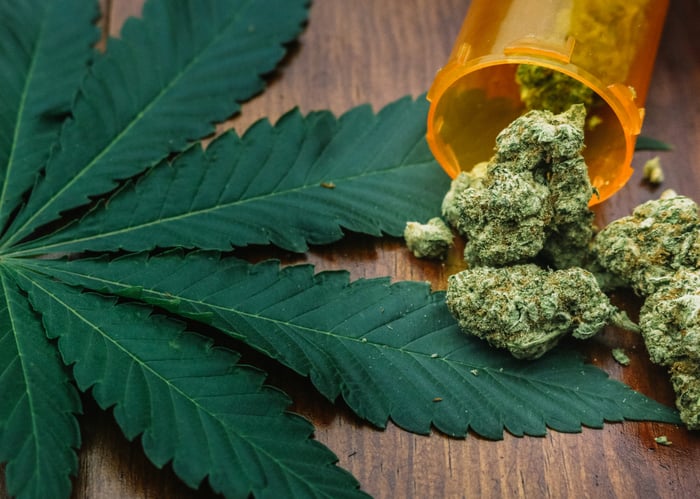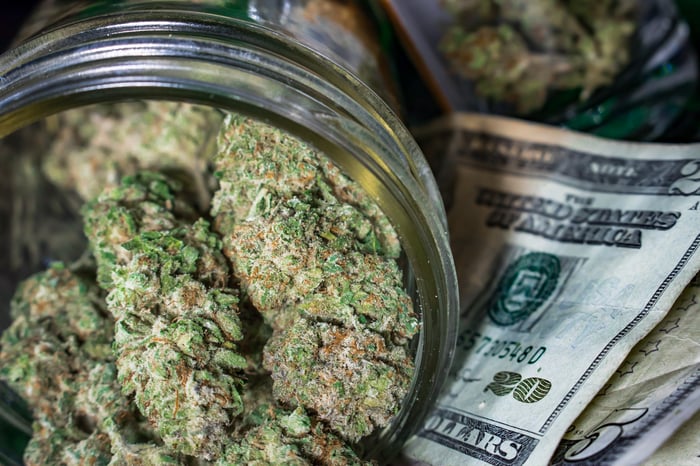Look, in the sky. It's a bird. It's a plane. No, it's the sky-high growth rate for legal North American marijuana. Last year alone, legal weed sales in North America soared to $9.7 billion, according to ArcView Market Research, and they could be on track to hit $24.5 billion by 2021. That's the type of growth that's had pot stock investors salivating with excitement, and it is a big reason behind the doubling or tripling in marijuana stocks over the trailing year.
Canada's maple leaf could turn green by this summer
However, all eyes are on our neighbor to the north, which is on the verge of becoming the first developed country in the world and only the second country overall, behind Uruguay, to legalize recreational marijuana. Canada legalized medicinal cannabis back in 2001, with Health Canada overseeing the industry ever since. Now, given the strong support for marijuana throughout much of North America, Canada's federal government looks to be just months away from legalizing the drug for adults ages 18 and over.

Image source: Getty Images.
What would legal weed mean for Canada? According to estimates, it would generate about $5 billion or more in additional revenue on top of what it's already receiving from medical cannabis domestically and from exports to medically legal countries. It would also likely lead to strong jobs creation directly within the cannabis industry (e.g., growers, processors, distributors, and dispensaries), as well as through indirect means (e.g., accounting, consulting, and financing).
Many of the hurdles the Canadian government was expected to face have been put into the rearview mirror. For instance, with conservatives in parliament clearly in the minority, their votes against expansion shouldn't be enough to keep the bill, C-45, from passing.
What's more, a two-year tax-sharing agreement has been forged between the federal government and all but one province (Manitoba), removing a key question mark about where the collected tax revenue would go. The provinces will receive 75% of the tax revenue for the first two years since they're on the front lines of regulation and enforcement, with the federal government getting the remainder.
Health Canada outlines new regulations, should recreational weed be legalized
But there are, as you might imagine, some wrinkles that need ironing out before the schedule June 7 Senate vote on C-45. This past week, Health Canada addressed a few of these remaining concerns by outlining recreational cannabis packaging requirements to keep adolescents from gaining access to pot, assuming C-45 becomes law, and the introduction of a new class of cultivation and processing licenses.

Image source: Getty Images.
With regard to packaging, Health Canada will require all recreational pot products be packaged in a tamper-evident, child-resistant opaque or translucent container. These containers have to include a health warning on a bright yellow background, a standard cannabis symbol, and note the tetrahydrocannabinol (THC) or cannabidiol content of the product. Furthermore, graphics or images will be prohibited, with branding and logos restricted. The packaging requirements are more or less what everyone in the industry expected.
Now, here's where things get interesting. Having already loosened its licensing regulations in May 2017 to allow new growers to enter the marketplace to meet medical cannabis demand, Health Canada on Monday, March 19, announced plans to introduce new micro-cultivation and micro-processing licenses. A micro-cultivation license would be issued to an authorized plant canopy area of less than 200 square meters (2,153 square feet), and a micro-processing license allowed for those processing less than 600 kilograms, or 1,323 pounds, of dried cannabis a year.
Why the new licenses? It's pretty evident that this is Health Canada's attempt to allow small businesses an opportunity to get their piece of the aforementioned $5 billion pie, which could prove even larger than these estimates.

Image source: Getty Images.
This new licensing policy could backfire
However, while Health Canada's intentions are good, this new licensing policy could wind up backfiring in a big way.
The biggest issue with legalizing recreational marijuana in Canada is that no one really has any idea what to expect with supply or demand because no developed country has ever legalized adult-use weed before. A handful of analyses and reports have suggested that demand for Canada could come in around 800,000 kilograms per year, but again this is a rough estimate at this point.
On the other hand, Canadian growers are expanding their capacity at a breakneck pace. Canopy Growth Corp. (CGC 1.28%), the largest pot stock by market cap in the world, already has seven facilities spanning 665,000 square feet and is in the process of constructing or developing greenhouses on 3.7 million more square feet in British Columbia. Though Canopy Growth has been tight-lipped about its annual capacity, it could easily wind up topping 300,000 kilograms a year.
Not too far behind Canopy Growth are the likes of Aurora Cannabis, Aphria, MedReleaf, and OrganiGram Holdings, which have forecast fully-funded annual outputs of 283,000 kilograms, 230,000 kilograms, 140,000 kilograms, and 113,000 kilograms, respectively. Some of these projects, such as with OrganiGram, could take until 2020 or 2021 to reach full production capacity. Nonetheless, these five growers alone are capable of producing close to 1.1 million kilograms of dried cannabis a year. That's well above the domestic demand prediction noted in reports and by analysts. Worse yet, it doesn't take into account the dozens of licensed cultivators not mentioned, as well as the new micro-cultivator licenses that are soon to be issued, assuming legalization.

Image source: Getty Images.
In plain English, in its effort to create a competitive marketplace that allows the little guy to succeed, Health Canada could be dooming Canada to rampant oversupply issues where margin collapses on dried cannabis in the years to come. Under such a scenario, the consumer could win (at least for a short amount of time), but smaller cultivators will be squashed by larger companies that have deeper pockets. Keep in mind this doesn't mean these larger pot stocks would do well. It just means they'll have the finances to survive some steep bumps in the road. It's possible that exporting dried cannabis could alleviate some of this expected weed glut, but it likely wouldn't alleviate all of it.
One more time, we don't really know what to expect with regard to supply or demand if Canada moves forward with legalization by this summer. But with the way things are playing out, oversupply is (pardon the pun) a growing possibility.




